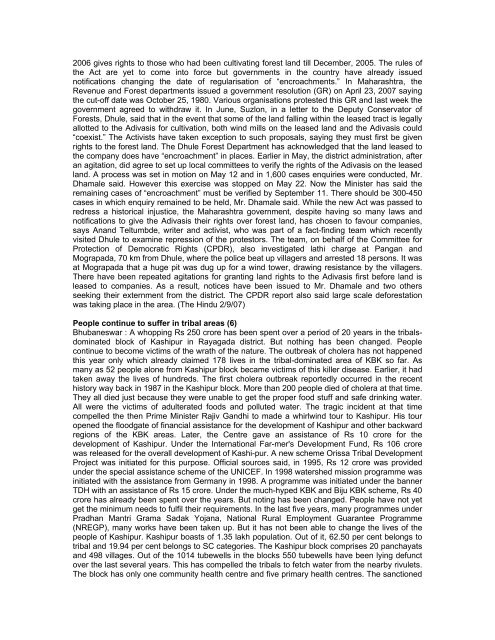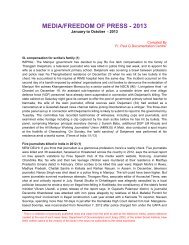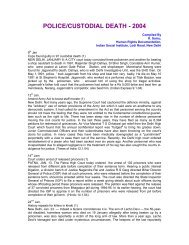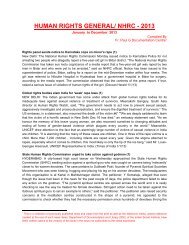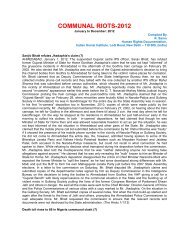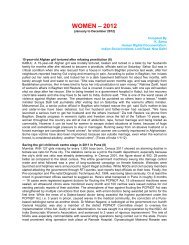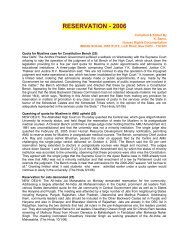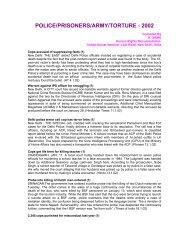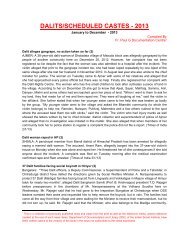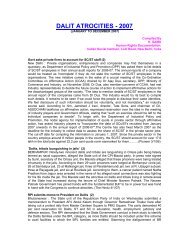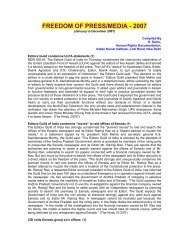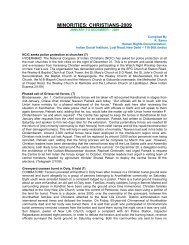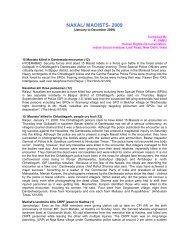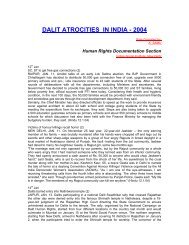2006 gives rights to those who had been cultivating forest land till December, 2005. The rules ofthe Act are yet to come into force but governments in the country have already issuednotifications changing the date of regularisation of “encroachments.” In Maharashtra, theRevenue and Forest departments issued a government resolution (GR) on April 23, <strong>2007</strong> sayingthe cut-off date was October 25, 1980. Various organisations protested this GR and last week thegovernment agreed to withdraw it. In June, Suzlon, in a letter to the Deputy Conservator ofForests, Dhule, said that in the event that some of the land falling within the leased tract is legallyallotted to the Adivasis for cultivation, both wind mills on the leased land and the Adivasis could“coexist.” The Activists have taken exception to such proposals, saying they must first be givenrights to the forest land. The Dhule Forest Department has acknowledged that the land leased tothe company does have “encroachment” in places. Earlier in May, the district administration, afteran agitation, did agree to set up local committees to verify the rights of the Adivasis on the leasedland. A process was set in motion on May 12 and in 1,600 cases enquiries were conducted, Mr.Dhamale said. However this exercise was stopped on May 22. Now the Minister has said theremaining cases of “encroachment” must be verified by September 11. There should be 300-450cases in which enquiry remained to be held, Mr. Dhamale said. While the new Act was passed toredress a historical injustice, the Maharashtra government, despite having so many laws andnotifications to give the Adivasis their rights over forest land, has chosen to favour companies,says Anand Teltumbde, writer and activist, who was part of a fact-finding team which recentlyvisited Dhule to examine repression of the protestors. The team, on behalf of the Committee forProtection of Democratic Rights (CPDR), also investigated lathi charge at Pangan andMograpada, 70 km from Dhule, where the police beat up villagers and arrested 18 persons. It wasat Mograpada that a huge pit was dug up for a wind tower, drawing resistance by the villagers.There have been repeated agitations for granting land rights to the Adivasis first before land isleased to companies. As a result, notices have been issued to Mr. Dhamale and two othersseeking their externment from the district. The CPDR report also said large scale deforestationwas taking place in the area. (The Hindu 2/9/07)People continue to suffer in tribal areas (6)Bhubaneswar : A whopping Rs 250 crore has been spent over a period of 20 years in the tribalsdominatedblock of Kashipur in Rayagada district. But nothing has been changed. Peoplecontinue to become victims of the wrath of the nature. The outbreak of cholera has not happenedthis year only which already claimed 178 lives in the tribal-dominated area of KBK so far. Asmany as 52 people alone from Kashipur block became victims of this killer disease. Earlier, it hadtaken away the lives of hundreds. The first cholera outbreak reportedly occurred in the recenthistory way back in 1987 in the Kashipur block. More than 200 people died of cholera at that time.They all died just because they were unable to get the proper food stuff and safe drinking water.All were the victims of adulterated foods and polluted water. The tragic incident at that timecompelled the then Prime Minister Rajiv Gandhi to made a whirlwind tour to Kashipur. His touropened the floodgate of financial assistance for the development of Kashipur and other backwardregions of the KBK areas. Later, the Centre gave an assistance of Rs 10 crore for thedevelopment of Kashipur. Under the International Far-mer's Development Fund, Rs 106 crorewas released for the overall development of Kashi-pur. A new scheme Orissa Tribal DevelopmentProject was initiated for this purpose. Official sources said, in 1995, Rs 12 crore was providedunder the special assistance scheme of the UNICEF. In 1998 watershed mission programme wasinitiated with the assistance from Germany in 1998. A programme was initiated under the bannerTDH with an assistance of Rs 15 crore. Under the much-hyped KBK and Biju KBK scheme, Rs 40crore has already been spent over the years. But noting has been changed. People have not yetget the minimum needs to fulfil their requirements. In the last five years, many programmes underPradhan Mantri Grama Sadak Yojana, National Rural Employment Guarantee Programme(NREGP), many works have been taken up. But it has not been able to change the lives of thepeople of Kashipur. Kashipur boasts of 1.35 lakh population. Out of it, 62.50 per cent belongs totribal and 19.94 per cent belongs to SC categories. The Kashipur block comprises 20 panchayatsand 498 villages. Out of the 1014 tubewells in the blocks 550 tubewells have been lying defunctover the last several years. This has compelled the tribals to fetch water from the nearby rivulets.The block has only one community health centre and five primary health centres. The sanctioned
strength of doctors for these hospitals is 12. But only two doctors are working in the areas on apermanent basis. Official sources said, the block officials have not been able to reach 70 per centof the remotest part of this block. Sources further said that most of the rice under several schemenever reaches to the beneficiaries but later it reaches to the rice-miller for the recycling purposes.Planning and Co-ordination Minister Padmanava Behera said, "Certain development has beenmade in the KBK areas. But more things have to be done particularly in the field of creating publicawareness." He further informed that Rs 1300 crore has already been spent for the overalldevelopment of KBK areas. Official sources claimed as most of the NGOs working in these areasstress on the welfare of their organisations, people continue to suffer. Similarly is the case of theGovernment officials working in KBK areas. Vigilance officials maintained that the officialsworking in KBK areas , try to siphoned off the money as much as they can from differentGovernment programmes implementing in the area. (Pioneer 4/9/07)Tribals attack forest officials (6)AHMEDABAD: At least 20 policemen and forest officials were said to be injured when about1,500 tribal people attacked a security party with bows and arrows near Umarpada in Suratdistrict in south Gujarat on Thursday. The forest staff along with the police went to Haripura andKajipura to evacuate the tribals cultivating forest land.The police claimed that the tribal people ofthe two villages had already been allocated alternative land near Ukai in lieu of forest land, butthey refused to shift. They insisted that they would cultivate the forest land they claimed to beholding for generations.Trouble had been brewing for the last few days and on Thursday whenthe forest department employees went to Umarpada the officials were attacked. (The Hindu7/9/07)DD Kashir accused of ignoring tribal languages (6)SRINAGAR: Gujjars of Jammu and Kashmir have accused Doordarshan’s Kashir Channel ofignoring the State’s tribal languages, especially Gojri, in its programmes and described it as a“cultural aggression” against the community. “The Doordarshan channel for Jammu and Kashmir,DD Kashir, launched by the Government of India with the objective of countering Pakistani mediapropaganda from across the border, has failed to serve its purpose in the tribal language Gojrispoken by nomad Gujjars of the State,” said Javaid Rahi, national secretary of the TribalResearch and Cultural Foundation, an organisation working for the overall development of thetribes of India. “I call it cultural aggression against the Gujjars of Jammu and Kashmir as thechannel does not telecast even a five-minute programme in Gojri, the language of about 25 percent of the State’s population, in its 24X7 telecasts and does not cover remote villages and tribalpopulation of the State in their own mother-tongue which is most affected by militancy. It,therefore, fails to counter the massive anti-India propaganda launched by Pakistan Televisionthrough its powerful transmitters in Gojri along the border,” said Dr. Rahi. This is the only regionalTV channel for which the Centre has allocated more than Rs. 299.87 crore for this year, he said,adding, “we are demanding a 10-minute Gojri news bulletin from Doordarshan Kendra Srinagarand Jammu.” Dr. Rahi said the local television networks of the Pakistan-occupied Kashmir,especially Muzaffarabad Television, have lately stepped up their propaganda programmes,especially news and current affairs programmes, in Gojri language to influence the Gujjars. “Thisneeds to be countered at the earliest so that they may not exploit and misguide the Gujjar tribalpopulation of the State in the name of region or religion,” Dr. Rahi said. He said threememorandums signed by Gojri writers were submitted to President Pratibha Patil, Prime MinisterManmohan Singh and Union Information and Broadcasting Minister P.R. Dasmunsi and a strongprotest was lodged against the Channel, but in vain. (The Hindu 7/9/07)Tribals to rally for their rights (6)SURAT/BHARUCH: To raise the issue of farm land for tribals of Umarpada, Lok SangharshMorcha (LSM) will organise a rally in Rajpipla on September 17. Ambrish Rai, national presidentof LSM, announced the future movement for tribal rights here on Saturday. Along with the issueof land in Umarpada taluka, other tribal-related issues will also be raised at the rally.Simultaneously, Pratibha Shinde of LSM addressed media in Bharuch on Saturday to announcethe rally on September 17. "We will protest with the help of thousands of tribals to show
- Page 8 and 9: eported that around 30 per cent of
- Page 10 and 11: Mr. Dinesh told PTI over phone. Pol
- Page 12 and 13: They said they will carry the logs
- Page 15 and 16: designs as there was now awareness
- Page 17 and 18: Rs 15,000 cr for Gujarat tribal dev
- Page 19: the Janmanch leaders to the negotia
- Page 22 and 23: Congress Committee submits that eve
- Page 24 and 25: was formed to orchestrate the plans
- Page 26 and 27: the highest green covers in the cou
- Page 28 and 29: 10,48,669 tribal families go for lo
- Page 30 and 31: play, was all praise for the stagec
- Page 32 and 33: Bangalore, May 6: In a first-of-its
- Page 34 and 35: we should not react to Mane and his
- Page 36 and 37: Tribals happy over UNICEF project (
- Page 38 and 39: the water for agricultural use to c
- Page 40 and 41: Meanwhile, the Chhattisgarh Police
- Page 42 and 43: Ratan and Dhirendra from Antarvelia
- Page 44 and 45: festival was carried to numerous nu
- Page 46 and 47: Addressing the gathering, prominent
- Page 48 and 49: characterised by extreme poverty le
- Page 51: Development Commissioner, Revenue S
- Page 54 and 55: Tribal varsity Bill introduced in R
- Page 58 and 59: government that the action against
- Page 60 and 61: Rabindra Nath Jarika,VVM leader, Su
- Page 62 and 63: Bhubaneswar : The tribals of backwa
- Page 64 and 65: Jaipur : An interim order of the Ra
- Page 66 and 67: Forest dwellers court arrest (6)New
- Page 68 and 69: forest cover, it said. The matter w
- Page 70 and 71: Minister promised them to look into
- Page 72 and 73: Law Ministry officials, however, no
- Page 74 and 75: and offered themselves for arrest.
- Page 76 and 77: Salwa Judum. Home Minister Ram Vich
- Page 78 and 79: esources hindered them from securin
- Page 80 and 81: Guwahati: One person was killed and
- Page 82 and 83: Locals clashed with the rallyists w
- Page 84 and 85: non-implementation of the Forest Ri
- Page 86 and 87: gardens and Adivasi villages during
- Page 88 and 89: state Government. But in the afterm
- Page 90 and 91: have already claimed their rehabili
- Page 92 and 93: educational institutions, markets a
- Page 94 and 95: motivated to become his disciples.
- Page 96 and 97: amenities," said Bratindi Jena of A


